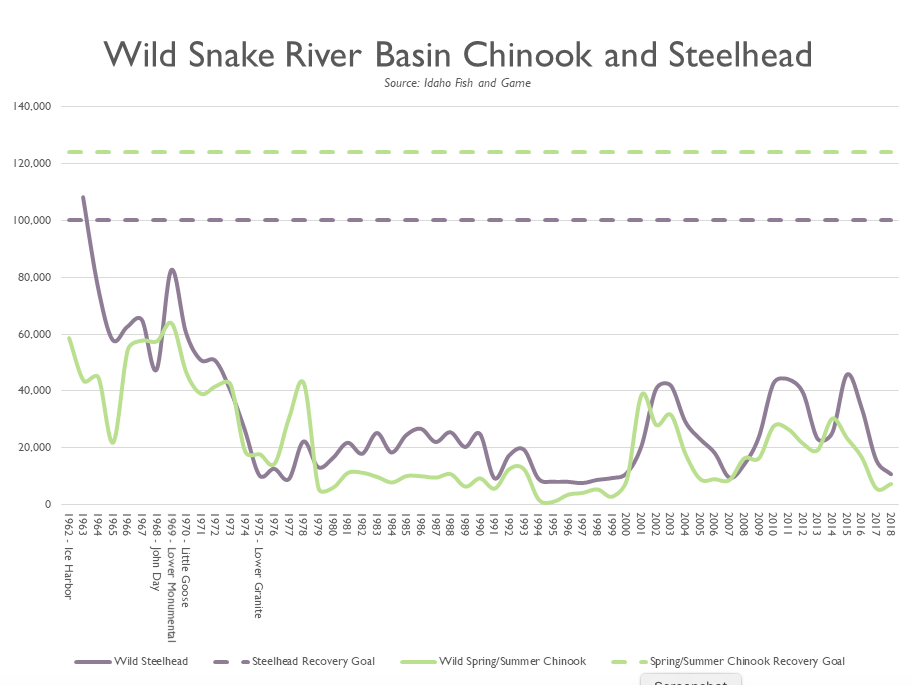forum
library
tutorial
contact

Washington’s 2018 State Of Salmon Report:
Six Columbia/Snake ESA Listed Stocks Not Making Progress
by Staff
Columbia Basin Bulletin, February 1, 2019
|
the film forum library tutorial contact |

|
Washington’s 2018 State Of Salmon Report:
by Staff
|
 Nearly $1 billion has been spent on salmon recovery activities in the State of Washington since 1999 when the Washington legislature passed the state's Salmon Recovery Act, according to an annual report released this month by Gov. Jay Inslee's Salmon Recovery Office.
Nearly $1 billion has been spent on salmon recovery activities in the State of Washington since 1999 when the Washington legislature passed the state's Salmon Recovery Act, according to an annual report released this month by Gov. Jay Inslee's Salmon Recovery Office.
Five stocks of endangered or threatened wild salmon, steelhead or bull trout are making progress toward recovery and two are near their recovery goals. Still, six of the state's listed stocks are not making progress and two are going backwards and are far from recovery.
According to the report upper Columbia River spring chinook salmon and Puget Sound chinook salmon are losing ground in the fight towards recovery.
On the other end of the recovery scale in Washington are Hood Canal summer chum salmon and Snake River fall chinook salmon that the report says are near their recovery goals.
"The statewide picture for salmon is clear. Challenges are outpacing solutions making salmon recovery efforts as vital now as they were 20 years ago," the report says.
"Progress in some sectors, such as hatcheries, harvest, and nearshore restoration, are being offset with challenges in other sectors such as general habitat loss, disease, predation, and invasive species," it continues. "In addition, warming oceans, changing stream environments, shifting food webs, and other issues associated with climate change are playing a greater role."
Showing signs of progress towards recovery, but not yet in the near-recovery category, are Mid-Columbia River steelhead, Lake Ozette sockeye, Lower Columbia River steelhead, Snake River steelhead and Puget Sound steelhead (actually, recovery goals are in progress for Puget Sound steelhead. Draft goals are here).
Not making progress are the Upper Columbia River steelhead, Lower Columbia River chum salmon, Lower Columbia River coho salmon, Lower Columbia River fall chinook, Lower Columbia River spring chinook and Snake River spring and summer chinook, the report shows.
"State of the Salmon in Watersheds 2018" can be found at here.
As salmon and steelhead populations have declined in the state, so has harvest of the fish.
"Salmon fishing in Washington has decreased dramatically since the early 1970s, affecting treaty tribes, recreational anglers, and the commercial fishing industry," the report says. "The drop in fishing is the direct result of the long-term decline in salmon caused by a variety of factors, such as habitat loss, dams, hatcheries, overfishing, predation, and invasive species, all exacerbated by climate change."
Fishing in the state relies heavily on hatchery-produced fish. However, harvest of salmon and steelhead is constrained due to too few wild fish.
In 1976, some 3,344,873 coho salmon were harvested by tribes, and commercial and recreational anglers. By 2017, that number had dropped to 445,075 coho harvested. Similarly, some 1,288,456 chinook salmon were harvested in 1976, dropping to 548,514 in 2017.
The 150 salmon, steelhead and bull trout populations are performing at different levels throughout the state. Summer chum are approaching recovery in both the Hood Canal and in the Strait of Juan de Fuca.
In the lower Columbia River, of the 74 populations of salmon, steelhead and bull trout, just eight are meeting recovery goals
In the mid-Columbia, runs are recovering, but work is still needed to remove fish passage barriers, restore key tributaries and floodplains and improve water management, according to the report.
In Puget Sound, 59 listed populations of chinook salmon, steelhead and bull trout are mostly in decline. "The greatest challenge," the report says, "is balancing the needs of the more than 4 million people living" there, while also protecting and restoring critical habitat.
In the Snake River, where "significant salmon recovery actions have occurred through regional collaboration," the largest hurdles to fish migration have been removed, sediment and temperature levels are the lowest since ESA listings, but more habitat actions are needed and there are unknown issues in fish survival, the report says.
In the upper Columbia, runs are nearly double what they were 10 years ago, but endangered spring chinook "are in desperate need of continued recovery efforts to survive," the report says.
Some $421 million has been spent in Washington over the past 20 years to restore habitat, $193 million to purchase lands, about $179 million for planning and assessment, $79 million for monitoring, $60.5 million for hatcheries, $29 million for other and $20 million for capacity.
While the Washington Recreation and Conservation Office has distributed $981,781,151 from 1999 through 2017, the money comes from a variety of state and federal sources. That amount doesn't include local matching sources, the report says, which would add more than $200 million.
State sources include Aquatic Lands Enhancement Account, Brian Abbott Fish Barrier Removal Board, Catastrophic Flood Relief program, Coastal Restoration Initiative Grants, Estuary and Salmon Restoration Program, Family Forest Fish Passage Program, Puget Sound Acquisition and Restoration Fund, Salmon Recovery Fund, Washington Wildlife and Recreation Program.
Federal Sources are Coded Wire Tag Program, Environmental Protection Agency, hatchery reform funds, Land and Water Conservation Fund, Marine Shoreline Protection, Pacific Coastal Salmon Recovery Fund, Pacific States Marine Fisheries Commission, and Puget Sound Chinook critical stock program.
Related Pages:
Washington ‘State of Salmon’ Report: Seven ESA-Listed Populations Showing No Recovery Progress by Staff, Columbia Basin Bulletin, 1/19/17
learn more on topics covered in the film
see the video
read the script
learn the songs
discussion forum
